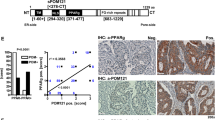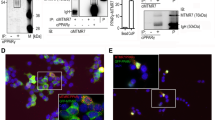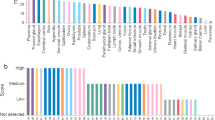Abstract
An inverse relationship exists between the expression of 15-lipoxygenase-2 (15-LOX-2) and peroxisome proliferator-activated receptor γ (PPARγ) in normal prostate epithelial cells (PrECs) compared with their expression in prostate carcinoma cells (PC-3). The reason for this difference, however, is unknown. We hypothesized that this inverse expression partly involves the 15-LOX-2 promoter and 15-S-hydroxyeicosatetraenoic acid (15-(S)-HETE), a product of 15-LOX-2 that binds to PPARγ. We identified an active steroid nuclear receptor half-site present in the 15-LOX-2 promoter fragment F-5 (−618/+177) that can interact with PPARγ. After forced expression of wild-type PPARγ, 15-(S)-HETE (1 μ M) decreased F-5 reporter activity in PrECs whereas forced expression of 15-LOX-2 resulted in 15-(S)-HETE production which enhanced F-5 activity in PC-3. In contrast, the expression of dominant-negative PPARγ reversed the transcriptional activation of F-5 by enhancing it 202-fold in PrEC or suppressing it in PC-3; the effect in PC-3 was positively increased 150-fold in the presence of 15-(S)-HETE (1 μ M). Peroxisome proliferator-activated receptor γ interacted with 15-LOX-2 promoter sequences in pulldown experiments using biotinylated 15-LOX-2 (−560/−596 bp) oligonucleotides. In gelshift analyses PPARγ and orphan receptor RORα were shown to interact with the F-5 fragment in PC-3 cells. These data suggest that crosstalk mechanisms exist between the 15-LOX-2 gene and PPARγ to counterbalance expression and help explain the inverse relationship of these genes in normal versus cancer cells.
This is a preview of subscription content, access via your institution
Access options
Subscribe to this journal
Receive 50 print issues and online access
$259.00 per year
only $5.18 per issue
Buy this article
- Purchase on Springer Link
- Instant access to full article PDF
Prices may be subject to local taxes which are calculated during checkout






Similar content being viewed by others

References
Berhane K, Boggaram V . (2001). Gene 268: 141–151.
Bhatia B, Maldonado CJ, Tang S, Chandra D, Klein RD, Chopra D et al. (2003). J Biol Chem 278: 25091–25100.
Bhatia B, Tang S, Yang P, Doll A, Aumueller G, Newman RA et al. (2005). Oncogene 24: 2583–3595.
Blanquart C, Barbier O, Fruchart JC, Staels B, Glineur C . (2003). J Steroid Biochem Mol Biol 85: 267–273.
Brash AR, Boeglin WE, Chang MS . (1997). Proc Natl Acad Sci USA 94: 6148–6152.
Butler R, Mitchell SH, Tindall DJ, Young CY . (2000). Cell Growth Differ 11: 49–61.
Cato AC, Nestl A, Mink S . (2002). Sci STKE 2002: RE9.
Elbrecht A, Chen Y, Cullinan CA, Hayes N, Leibowitz M, Moller DE et al. (1996). Biochem Biophys Res Commun 224: 431–437.
Flores AM, Li L, McHugh NG, Aneskievich BJ . (2005). Chem Biol Interact 151: 121–132.
Giguere V, Tini M, Flock G, Ong E, Evans RM, Otulakowski G . (1994). Genes Dev 8: 538–553.
Gurnell M, Wentworth JM, Agostini M, Adams M, Collingwood TN, Provenzano C et al. (2000). J Biol Chem 275: 5754–5759.
Hsi LC, Wilson LC, Eling TE . (2002). J Biol Chem 277: 40549–40556.
Huang JT, Welch JS, Ricote M, Binder CJ, Willson TM, Kelly C et al. (1999). Nature 400: 378–382.
Jack GS, Brash AR, Olson SJ, Manning S, Coffey CS, Smith Jr JA et al. (2000). Hum Pathol 31: 1146–1154.
Kang LT, Vanderhoek JY . (1998). J Lipid Res 39: 1476–1482.
Kilty I, Logan A, Vickers PJ . (1999). Eur J Biochem 266: 83–93.
Kim J, Yang P, Sabichi A, Llansa N, Mendoza G, Subbarayan V et al. (2005). Cancer Res 65: 6189–6198.
Koeffler H . (2003). Clin Cancer Res 9: 1–9.
Krieg P, Marks F, Furstenberger G . (2001). Genomics 73: 323–330.
Mangelsdorf DJ, Thummel C, Beato M, Herrlich P, Schutz G, Umesono K et al. (1995). Cell 83: 835–839.
Moretti RM, Marelli MM, Motta M, Limonta P . (2002). Oncol Rep 9: 1139–1143.
Moretti RM, Marelli MM, Motta M, Polizzi D, Monestiroli S, Pratesi G et al. (2001). Prostate 46: 327–335.
Moretti RM, Montagnani Marelli M, Sala A, Motta M, Limonta P . (2004). Int J Cancer 112: 87–93.
Nagy L, Tontonoz P, Alvarez JG, Chen H, Evans RM . (1998). Cell 93: 229–240.
Salas TR, Reddy SA, Clifford JL, Davis RJ, Kikuchi A, Lippman SM et al. (2003). J Biol Chem 278: 41338–41346.
Schreiber E, Matthias P, Muller MM, Schaffner W . (1989). Nucleic Acids Res 17: 6419.
Shankaranarayanan P, Nigam S . (2003). J Immunol 170: 887–894.
Shappell SB, Boeglin WE, Olson SJ, Kasper S, Brash AR . (1999). Am J Pathol 155: 235–245.
Shappell SB, Gupta RA, Manning S, Whitehead R, Boeglin WE, Schneider C et al. (2001). Cancer Res 61: 497–503.
Sharma GD, Ottino P, Bazan NG, Bazan HE . (2005). J Biol Chem 280: 7917–7924.
Steinhilber D, Brungs M, Werz O, Wiesenberg I, Danielsson C, Kahlen JP et al. (1995). J Biol Chem 270: 7037–7040.
Subbarayan V, Sabichi AL, Kim J, Llansa N, Logothetis CJ, Lippman SM et al. (2004). Cancer Epidemiol Biomarkers Prev 13: 1710–1716.
Subbarayan V, Sabichi AL, Llansa N, Lippman SM, Menter DG . (2001). Cancer Res 61: 2720–2726.
Subbarayan V, Xu XC, Kim J, Yang P, Hoque A, Sabichi AL et al. (2005). Neoplasia 7: 280–293.
Tang S, Bhatia B, Maldonado CJ, Yang P, Newman RA, Liu J et al. (2002). J Biol Chem 277: 16189–16201.
Tang S, Bhatia B, Zhou J, Maldonado CJ, Chandra D, Kim E et al. (2004). Oncogene 23: 6942–6953.
Warnmark A, Treuter E, Wright AP, Gustafsson JA . (2003). Mol Endocrinol 17: 1901–1909.
Wigren J, Surapureddi S, Olsson AG, Glass CK, Hammarstrom S, Soderstrom M . (2003). J Endocrinol 177: 207–214.
Xu XC, Shappell SB, Liang Z, Song S, Menter D, Subbarayan V et al. (2003). Neoplasia 5: 121–127.
Acknowledgements
We thank Dr IC Kilty (Pfizer Global Research and Development, Sandwich, Kent, UK) for providing the 15-LOX-2 expression plasmid, Dr VKK Chatterjee (University of Cambridge, Cambridge, UK) for the dnPPARγ expression plasmid, Dr V Giguere (University of McGill, Canada) for the RORα 1 expression vector and Dr Alex Elbrecht (Merck & Co., Inc. NJ, USA) for the hPPARγ expression plasmids. This work was supported by Grant TPRN-99-240-01-CNE-1 from the American Cancer Society and by National Cancer Institute Grants P01 CA-91844, R21 CA-10241 and R21 CA-102145 and a grant from the Cancer Research and Prevention Foundation. Also supported in part by a National Cancer Institute grant CA-16672-28. We also thank Dr EM McDonald in the Department of Scientific Publications at M. D. Anderson Cancer Center for editorial expertise.
Author information
Authors and Affiliations
Corresponding author
Rights and permissions
About this article
Cite this article
Subbarayan, V., Krieg, P., Hsi, L. et al. 15-Lipoxygenase-2 gene regulation by its product 15-(S)-hydroxyeicosatetraenoic acid through a negative feedback mechanism that involves peroxisome proliferator-activated receptor γ. Oncogene 25, 6015–6025 (2006). https://doi.org/10.1038/sj.onc.1209617
Received:
Revised:
Accepted:
Published:
Issue Date:
DOI: https://doi.org/10.1038/sj.onc.1209617
Keywords
This article is cited by
-
The role of Lipoxin A4 in endometrial biology and endometriosis
Mucosal Immunology (2013)
-
Transgenic expression of 15-lipoxygenase 2 (15-LOX2) in mouse prostate leads to hyperplasia and cell senescence
Oncogene (2010)
-
Synergistic effect of 15-lipoxygenase 2 and radiation in killing head-and-neck cancer
Cancer Gene Therapy (2008)
-
Lipoxygenase-derived Metabolites Are Regulators of Peroxisome Proliferator-activated Receptor -2 Expression in Human Vascular Smooth Muscle Cells
American Journal of Hypertension (2008)


